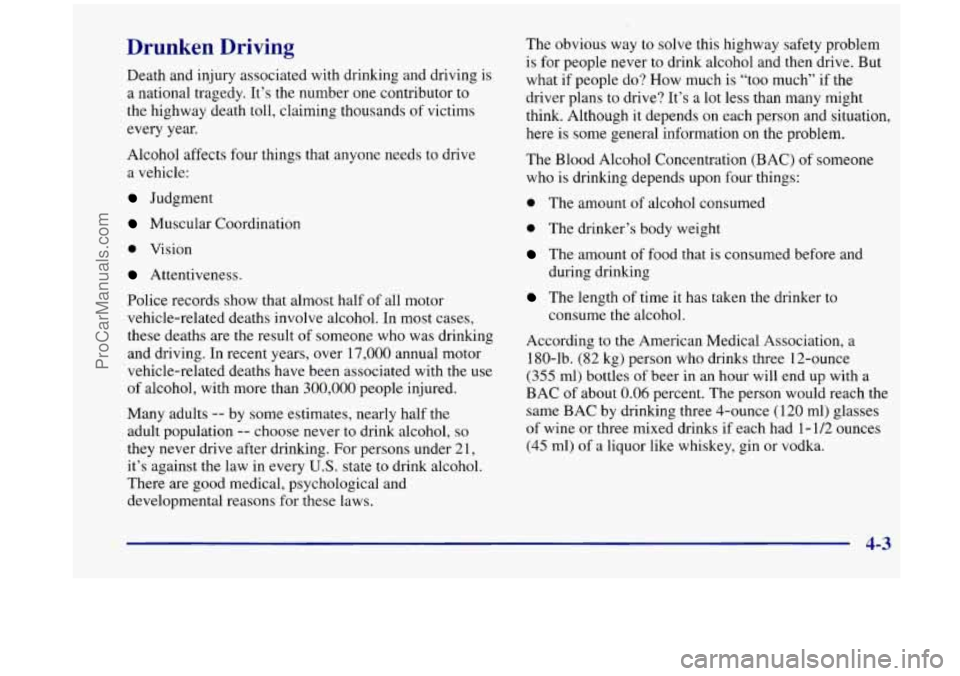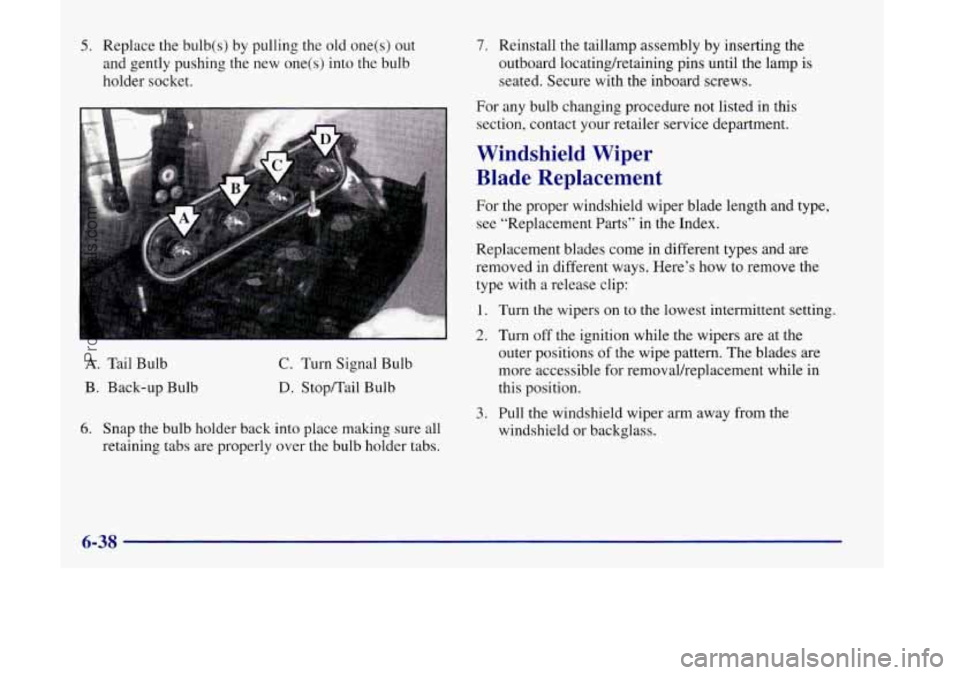Page 235 of 444

Drunken Driving
Death and injury associated with drinking and driving is
a national tragedy. It’s the number one contributor to
the highway death toll, claiming thousands of victims
every year.
Alcohol affects four things that anyone needs to drive
a vehicle:
Judgment
Muscular Coordination
0 Vision
Attentiveness.
Police records show that almost half of all motor
vehicle-related deaths involve alcohol. In most cases,
these deaths are the result of someone who was drinking
and driving. In recent
years, over 17,000 annual motor
vehicle-related deaths have been associated with the use
of alcohol, with more than 300,000 people injured.
Many adults
-- by some estimates, nearly half the
adult population
-- choose never to drink alcohol, so
they never drive after drinking. For persons under 21,
it’s against the law in every
U.S. state to drink alcohol.
There are good medical, psychological and
developmental reasons for these laws. The
obvious way to solve this highway safety problem
is for people never to drink alcohol and then drive. But
what if people do? How much
is “too much” if the
driver plans to drive? It’s a lot less than many might
think. Although it depends on each person and situation,
here is some general information on the problem.
The Blood Alcohol Concentration
(BAC) of someone
who is drinking depends upon four things:
0 The amount of alcohol consumed
0 The drinker’s body weight
The amount of food that is consumed before and
during drinking
The length of time it has taken the drinker to
consume the alcohol.
According to the American Medical Association, a
180-lb. (82 kg) person who drinks three 12-ounce
(355 ml) bottles of beer in an hour will end up with a
BAC of about 0.06 percent. The person would reach the
same BAC by drinking three 4-ounce (120 ml) glasses
of wine or three mixed drinks if each had 1 - 1/2 ounces
(45 ml) of a liquor like whiskey, gin or vodka.
4-3
ProCarManuals.com
Page 341 of 444
Jump Starting
For jump starting instructions, see “Jump Starting” in
the Index.
Bulb Replacement
Halogen Bulbs
I A CAUTWN:
Halogen bulbs have pressurized gas inside and
can burst if you drop or scratch the bulb. You or
others could be injured. Be sure to read and
follow the instructions on the bulb package.
Headlamps
I NOTICE:
When replacing the headlamp bulb, do not leave
the bulb out for any length
of time. This could
cause nitrogen gas to escape from the lamp. To
minimize nitrogen gas from escaping within the
headlamp, the headlamp must be placed
on a flat
surface with the lens facing down when removing
the bulb.
1. Open the hood.
2. Remove the front parkinghurn signal lamp assembly.
See “Front Parking/Turn Signal
Lamps” later in
this section.
6-31
ProCarManuals.com
Page 348 of 444

5. Replace the bulb(s) by pulling the old one(s) out
and gently pushing the
new one(s) into the bulb
holder socket.
7. Reinstall the taillamp assembly by inserting the
outboard locatingketaining pins until the lamp is
seated. Secure with the inboard screws.
For any bulb changing procedure not listed in this
section, contact your retailer service department.
Windshield Wiper
Blade Replacement
For the proper windshield wiper blade length and type,
see “Replacement Parts” in the Index.
Replacement blades come in different types
and are
removed
in different ways. Here’s how to remove the
type with a release clip:
1. Turn the wipers on to the lowest intermittent setting.
2. Turn off the ignition while the wipers are at the
outer positions of the wipe pattern. The blades are
more accessible for removalheplacement while in
A. Tail Bulb C. Turn Signal Bulb
B. Back-up Bulb D. Stop/Tail Bulb this position.
6. Snap the bulb holder back into place making sure all
retaining tabs
are properly over the bulb holder tabs.
3. Pull the windshield wiper arm away from the
windshield
or backglass.
6-38
ProCarManuals.com
Page 375 of 444

Vehicle Dimensions - Regular
Wheel Base
Length ................. 187.4 inches (475.9 cm)
Width
...................... 72 inches (183 cm)
Height
................... 67.4 inches (1 7 1.2 cm)
Wheelbase
................ 11 2 inches (284.5 cm)
Front Tread Width
......... 6 1.5 inches (1 56.2 cm)
Rear Tread Width
.......... 63.3 inches (1 60.8 cm)
Vehicle Dimensions - Extended
Wheel Base
Length ................. 20 1.4 inches (5 1 1.5 cm)
Width
................... 72.2 inches (183.4 cm)
Height
................... 68.1 inches (172.9 cm)
Wheelbase
................ 120 inches (304.7 cm)
Front Tread Width
......... 6 1.5 inches (156.2 cm)
Rear Tread Width
.......... 63.3 inches ( 160.8 cm)
Normal Maintenance
Replacement Parts
Air Cleaner Filter ............. AC Type A- 1208C
Passenger Compartment Air Cleaner Filter
(2) ............... 52470574
Engine Oil Filter
........................ PF47
Spark Plugs
................... AC Type 4 1-940
Gap: 0.060 inches (1.5 mm)
Windshield Wiper Blades
Length
..................... 24 inches (60 cm)
Type
......................... Shepard’s Hook
Length
.................... 16 inches (40.6 cm)
Type
......................... Shepard’s Hook
Backglass Wiper Blade
Air Conditioning Refrigerants
Not all air conditioning refrigerants are the same.
If the air conditioning system in your vehicle needs
refrigerant, be sure the proper refrigerant is used.
If
you’re not sure, ask your retailer.
6-65
ProCarManuals.com